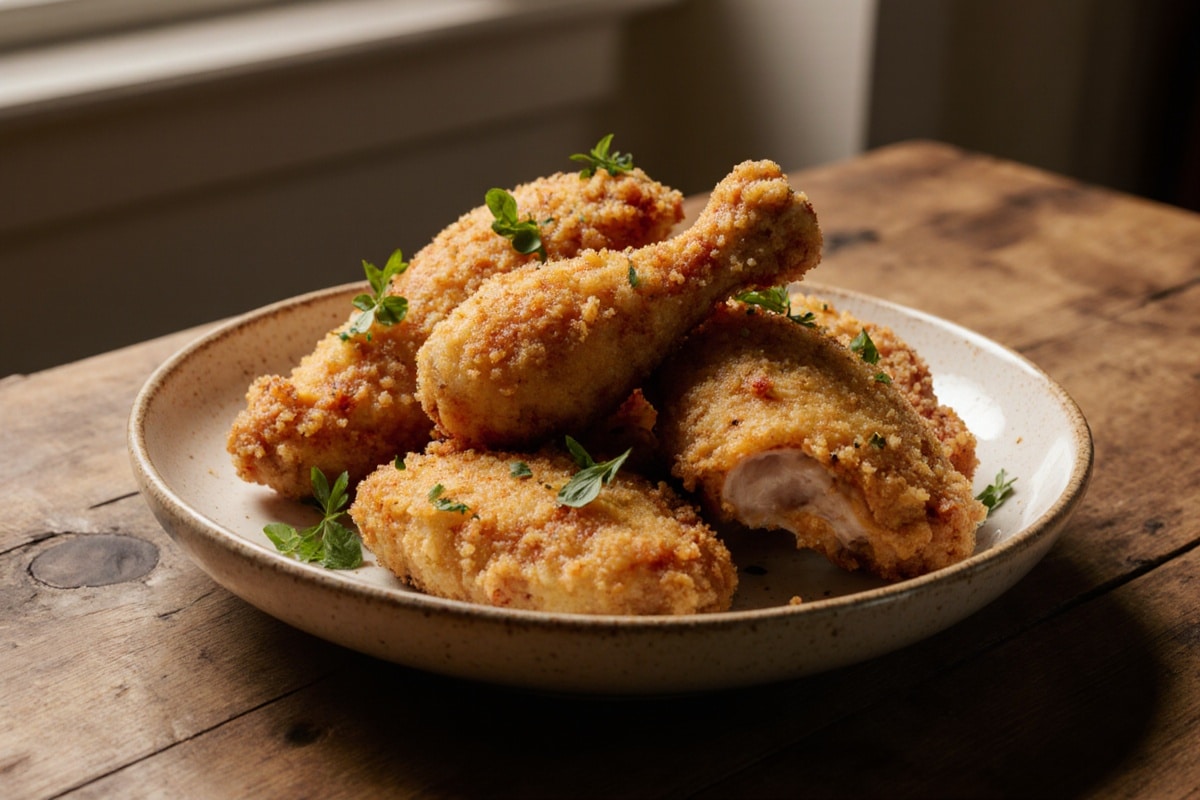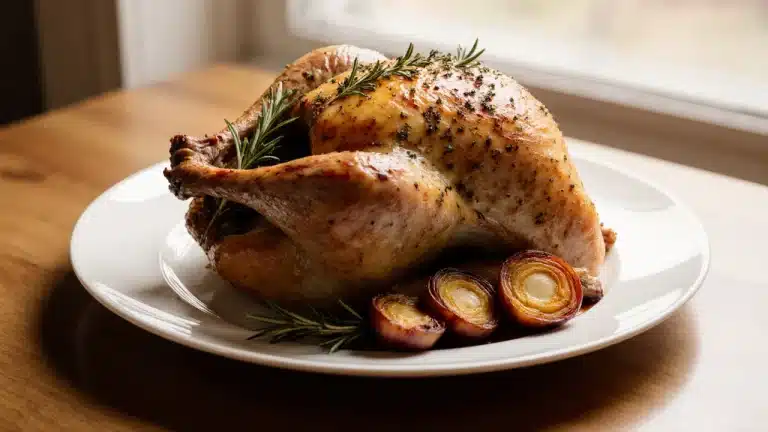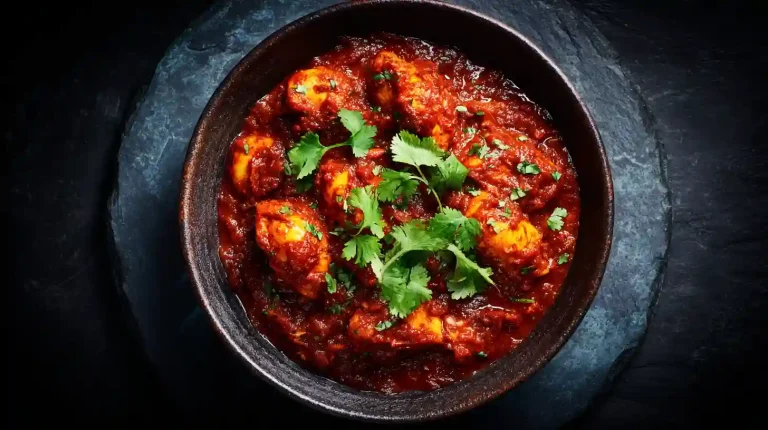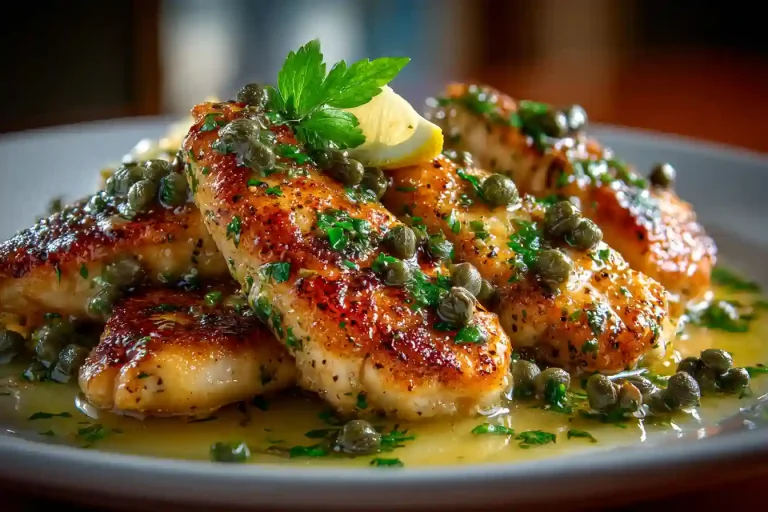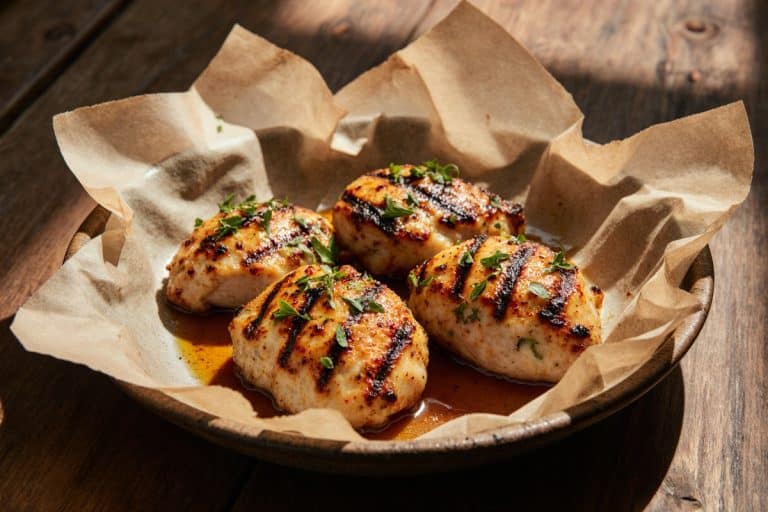Gordon Ramsay Buttermilk Fried Chicken Recipe
Gordon Ramsay buttermilk fried chicken is my go-to for crispy, juicy bliss. After years of experimenting, I realized the secret isn’t just in the frying; it’s all about that buttermilk marinade! I used to rush through the prep, thinking time wasn’t on my side, but now I know that letting the chicken soak overnight transforms it into something legendary. The flavors penetrate, the meat tenderizes, and you can wave goodbye to dry, sad chicken forever. Plus, you’ll gain mad confidence at your dinner table when everyone goes wild for that crispy golden crust. I’m rolling up my sleeves and sharing every detail, so let’s do this right and make it unforgettable!

Buttermilk marinade — the foundation for gordon ramsay buttermilk fried chicken
Ingredients and exact measurements for the marinade
Here’s the working marinade I use: 900 g bone-in chicken pieces (thighs and drumsticks), 600 ml buttermilk, 15 g kosher salt, 10 g granulated sugar, 5 g black pepper, 3 garlic cloves smashed, and the zest of 1 lemon. For extra lift add 15 ml Worcestershire sauce. Toss the chicken in the buttermilk so each piece is fully submerged.
I stick to grams and millilitres for consistency: 600 ml buttermilk for ~900 g chicken gives good acid contact without over-softening. Tip: weigh your chicken — uneven pieces cook badly. If you don’t have buttermilk, mix 600 ml milk + 30 ml white vinegar and rest 10 minutes.
Keep the marinade simple — acid, salt, aromatics. Those three do the work to tenderize and season. Use this baseline and scale up or down as needed: 600 ml per 900 g equals about 300 ml (1.25 cups) per 450 g chicken if you prefer imperial conversions.
How long to marinate, chill temps and food-safety rules
I marinate 8–24 hours in the fridge at 4 °C (40 °F) or below. Don’t skip refrigeration; raw chicken must never sit at room temperature for more than 2 hours. Shorter times (2–4 hours) still tenderize, but an overnight soak lets salt penetrate for better seasoning.
If I’m short on time I use a zip-top bag, massage the buttermilk into the meat for 20 minutes at room temp, then refrigerate. For very large pieces (whole breasts) push closer to 24 hours but not beyond — too long yields a mealy texture.
Before coating, remove chicken from the fridge and let it sit 20–30 minutes to take the chill off. Cold chicken hitting hot oil causes wild temperature swings. Aim for room-adjacent temperature, not warm.
Marinade variations and add-ins that actually work
Want to experiment? Add 10 g smoked paprika for sweet smoke or 5 g cayenne for heat. A tablespoon (15 ml) of chopped fresh rosemary works with the rosemary honey yam hash side. Swap 15 ml Dijon mustard for tang, or stir in 10 g grated onion powder for depth.
Acid helps tenderize, and enzymes can too. Add 30 g mashed pineapple or 15 g grated ginger for extra tenderizing, but limit marinating to under 6 hours to avoid mush. If you’re going herb-forward, throw in thyme sprigs and crushed black peppercorns.
Make small changes and test. Don’t overload sugar or strong enzymes unless you want a different texture. Change one thing at a time so you know what improved the result.
Prep the bird — portioning, brining alternatives, and practical kitchen hacks
Cutting and portion sizes with target weights and cook logic
Cutting to consistent sizes equals even cooking. Aim for pieces around 150–200 g each for drumsticks and 200–250 g for thighs. If you use breasts, butterfly or halve them to 150–200 g per piece.
Trim excess fat and silver skin, then pat each piece dry on paper towels before dredging; too much surface moisture ruins the crust. I use a digital probe thermometer and write target core temps on a scrap of paper — no guessing.
Label mixed-size pieces and adjust oil-to-pan ratios for small versus large pieces. Practical prep saves headaches at fry time.
Quick brine option vs. buttermilk-only approach
If you don’t have time for an overnight buttermilk soak, try a quick salt brine: 30 g salt per litre water for 30–60 minutes at 4 °C (40 °F). It improves juiciness and seasoning but lacks the tang and softening of buttermilk.
You can combine methods: quick brine 30–60 minutes, rinse, then marinate in buttermilk 4–8 hours. If you combine, halve the added salt in the buttermilk to avoid oversalting. Don’t brine more than 2 hours for small pieces unless you want denser texture.
Both routes work. Choose based on time and whether you want more moisture or more tang and tenderness.
Drying, chilling and the rest before coating
After removing from the marinade, let each piece drain 10 minutes on a wire rack, then transfer to a baking tray and chill uncovered 30–60 minutes. That tacky surface helps the flour stick and gives a crisper crust.
If I’m rushed I pat dry with paper towels but don’t over-dry — some tack is good. Too-wet pieces shed their coating into the oil. Resting on a rack rather than a plate prevents sogginess from pooling liquid.
Don’t skip this step. Let the surface set so the coating behaves when it hits hot oil.
Double-dredge coating and seasoning — Ramsay-style fried chicken crust tips
Flour mix, seasoning ratios and weight measures
The basic coating I use: 400 g plain (all-purpose) flour, 80 g cornflour (cornstarch) for extra crunch, 15 g kosher salt, 10 g smoked paprika, 5 g cayenne, 5 g garlic powder, 5 g onion powder, 3 g black pepper, and 5 g dried thyme. Mix and weigh your dry mix for consistency.
Cornflour reduces gluten development and gives that shatter-crisp coating. Salt matters—don’t skimp. If you want less heat, halve the cayenne and boost smoked paprika.
Measure by weight: 400 g flour to 80 g cornflour gives a 5:1 ratio that scales. Whisk well and sift if you prefer a finer blend. This is your baseline for the double dredge.
Step-by-step double-dredge buttermilk chicken coating
- Shake off excess marinade.
- Toss in dry mix and press the flour into the surface to form a first coat.
- Dip back into a quick wash (1 beaten egg + 60 ml water) or a buttermilk slurry for extra adhesion.
- Final dredge in the dry mix, pressing firmly.
The double-dredge creates layers: base adhesive plus a final crisp shell. Use a cooling rack to set the coated pieces 20–30 minutes before frying — this helps the crust stick and cuts sloughing. Avoid shaking off too much flour between steps; you want visible, pressed-on breading.
This method is often called the double dredge buttermilk fried chicken coating, and it’s the key to a sturdy crust that survives hot oil without falling apart.
Common coating mistakes and how to fix them
- Mistake: coating falling off in the oil. Fix: ensure chicken is tacky, press flour onto the surface, and rest coated pieces 20–30 minutes uncovered.
- Too-wet wash? Reduce the wash liquid or add more flour.
- If crust burns before interior hits 75 °C (165 °F), your oil is too hot. Lower to 170 °C (340 °F) and finish at 160 °C (320 °F).
- If crust is pale and soggy, oil is too cool — raise to 175–180 °C (347–356 °F) and watch with a thermometer.
- If your dredge clumps, sift the mix and toss pieces individually instead of dumping them together.
Fix problems as they happen — don’t keep frying bad batches and expect them to improve.
Cooking methods compared — deep-fry, pan-fry, oven and air fryer options
Deep-frying: best oil, temps, and precise cook times
For deep-frying I choose a neutral oil with a high smoke point: refined peanut, sunflower, or rice bran. Best choices are refined peanut or rice bran, with smoke points around 230 °C (446 °F). Use enough oil to cover half to two-thirds of the pieces — roughly 2–3 litres for a 26 cm (10″) Dutch oven with 900 g chicken.
Start at 175 °C (347 °F) for initial browning, then maintain 160–175 °C (320–347 °F) during cooking. Fry thighs and drumsticks 12–15 minutes, breasts 10–14 minutes depending on size. Target core temp 75 °C (165 °F) in the thickest part. Rest 5 minutes on a rack before serving.
Keep batches small to avoid temperature drop. Use a thermometer; guessing ruins both crust and confidence. When I want a gordon ramsay buttermilk fried chicken result at home, I watch temps like a hawk.
Shallow pan-frying and skillet method with times and tips
Shallow pan-frying uses about 3–5 mm oil depth in a wide skillet. Heat oil to 170–175 °C (338–347 °F) — test with a thermometer or drop a pinch of flour; it should sizzle immediately. Cook pieces skin-side first 6–8 minutes, then turn and cook another 6–8 minutes, adjusting for size.
Use a cast-iron skillet for steady heat, but don’t overcrowd. Flip only once or twice to keep the crust intact. If the crust browns too fast, lower heat to 160 °C (320 °F) and finish with a lid on for 2–3 minutes to stabilize internal temperature — watch for sogginess.
Shallow frying uses less oil and gives good contact heat. Expect slightly less uniform browning than deep-frying. Probe to 75 °C (165 °F).
Oven and air-fryer alternatives with exact temps and timing
Oven method: preheat to 205 °C (400 °F). Place coated pieces on a wire rack over a baking tray, spritz with oil, and bake 30–40 minutes for thighs/drumsticks, flipping at 20 minutes. Finish under the broiler 1–2 minutes for extra color. Target core temp 75 °C (165 °F).
Air fryer: preheat to 200 °C (392 °F), cook in a single layer 18–22 minutes, flipping at 10 minutes. Lightly spray with oil. The air fryer gives good crisp without as much oil but needs small batches to avoid crowding.
Oven and air-fryer methods trade ultimate crisp for convenience and lower oil use. If you want Ramsay-style fried chicken crust with less oil, the air fryer is a reasonable compromise — the texture will be slightly different.
Sauces, sides and serving — including rosemary honey yam hash
Three sauce options that actually pair well
Option 1 — Classic hot honey: 75 g honey warmed with 5 g cayenne and 15 ml apple cider vinegar. Brush lightly over hot chicken for a sweet-spicy finish.
Option 2 — Lemon garlic aioli: 120 g mayonnaise, 10 g lemon zest, 15 ml lemon juice, 10 g minced garlic, salt to taste. Use as a dip.
Option 3 — Herby yoghurt dip: 200 g Greek yoghurt, 15 g chopped parsley, 10 ml olive oil, 10 g chopped chives, pinch of salt.
Each sauce shifts the dish: hot honey adds contrast, aioli adds richness, yoghurt brings brightness. I serve sauces on the side so the crust stays crisp. Make them ahead; they keep refrigerated 3–4 days.
Rosemary honey yam hash side dish (exact recipe)
Ingredients: 600 g yams (sweet potatoes), 30 ml olive oil, 1 medium onion finely chopped (100 g), 2 cloves garlic minced, 10 g fresh rosemary chopped, 30 ml honey, 15 ml lemon juice, salt and pepper. Peel and dice yams into 1.5 cm cubes for even cooking.
Method: Parboil yams 6–8 minutes until just tender, drain well. Heat oil in a skillet, sweat onion and garlic 3–4 minutes until translucent. Add yams and rosemary and sauté over medium-high 6–8 minutes to get golden edges.
Stir in honey and lemon juice for 1 minute, season to taste, and serve hot. Make ahead and reheat in a skillet 3 minutes to refresh the caramelization.
Plating, pairings and 2–3 serving suggestions
- Family plate — 2 pieces per person with rosemary honey yam hash and a lemon wedge; drizzle hot honey at the table.
- Sandwich — slice warm thigh meat, pile on toasted brioche with slaw (200 g shredded cabbage, 30 ml mayo, 15 ml apple cider), and aioli.
- Picnic style — cold fried chicken served with herby yoghurt dip and pickled cucumber ribbons.
Add something bright (lemons, pickles, slaw) to cut the fat. Presentation matters less than contrast — acid and crunch rescue heavy dishes. For drinks, a crisp lager or a high-acid white like Sauvignon Blanc works well with the crust.
Nutrition, storage, common mistakes and three solid variations
Nutrition, benefits and rough calorie guidance
A typical serving (one thigh ~200 g cooked) of buttermilk fried chicken runs roughly 400–550 kcal depending on oil absorption and coating. Protein per piece is about 25–30 g. Buttermilk adds calcium and some live cultures if unheated, and dark meat keeps iron higher. Shallow frying or air-frying reduces oil uptake.
Balance is the takeaway: pair the chicken with high-fiber sides (greens, yams) to feel satisfied without overdoing it. If you bake or air-fry instead of deep-frying, subtract about 10–15 g fat from the total. For precise nutrition, weigh finished portions — oil absorption varies.
Storage, reheating, and safety rules
Cool to room temp no more than 2 hours after cooking, then refrigerate in an airtight container up to 3–4 days. For longer storage, freeze in single layers on a tray, then bag and freeze up to 3 months. Thaw overnight in the fridge.
Reheat in a 190 °C (375 °F) oven on a wire rack for 8–12 minutes until core temp reaches 75 °C (165 °F) to restore crisp. Avoid microwaves — they ruin texture. Always check core temp with a probe; reheated chicken must reach 75 °C (165 °F).
If the crust softens, a quick blast under a hot broiler for 1–2 minutes will help.
Buttermilk fried chicken common mistakes and quick fixes
- Oil too hot → burnt crust, raw interior. Fix: lower heat, finish at lower temps and probe to 75 °C (165 °F).
- Coating falling off. Fix: press flour on, rest coated pieces 20–30 minutes, fry in small batches.
- Greasy, soggy crust. Fix: maintain oil temp, drain on a rack, and don’t stack pieces.
- Shriveling from overcooking. Let meat rest 5 minutes before serving.
If you get a rubbery texture, you likely over-marinated or overcooked — shorten the acid time and watch internal temps. Learn to read the thermometer before you rely on color.
Three variations — spicy, gluten-free, and herb-crusted options
Spicy: Increase cayenne to 10 g, add 10 g smoked chipotle powder, and make hot honey with extra cayenne. For layered heat, try a 15 ml sriracha wash between dredges.
Gluten-free: Swap 400 g rice flour or a 200 g rice flour + 200 g potato starch blend for the all-purpose mix, and use cornstarch (80 g) as the crisping agent. Keep oil and workspace gluten-free to avoid cross-contamination.
Herb-crusted: Add 20 g finely chopped fresh parsley, 10 g thyme leaves, and 10 g rosemary to the dry mix. Press the herb-infused second dredge firmly into the surface for an aromatic crust that pairs well with rosemary honey yam hash.
Pick the variation that suits your crowd — spicy for beer drinkers, gluten-free for restricted diets, herb-crusted for a more elegant plate.
Buttermilk Fried Chicken
Ingredients
Equipment
Method
- Marinate chicken in buttermilk, salt, sugar, pepper, garlic, and lemon zest for 8–24 hours in the fridge.
- Remove chicken from the fridge; let it sit for 20–30 minutes to take the chill off.
- Prepare the dry mix: combine flour, cornflour, salt, smoked paprika, cayenne, garlic powder, onion powder, black pepper, and thyme.
- Coat chicken by tossing in the dry mix, dipping in a wash (1 beaten egg + 60 ml water), then dredging again in the dry mix.
- Let coated chicken rest on a rack for 20–30 minutes before frying.
- Heat oil to 175 °C (347 °F). Fry chicken, thighs/drumsticks for 12–15 minutes, breasts for 10–14 minutes, until golden and core temp reaches 75 °C (165 °F).
- Rest the cooked chicken on a wire rack for 5 minutes before serving.
- For the yam hash, parboil yams until tender, sauté onion and garlic in oil, then add yams and rosemary. Stir in honey and lemon juice before serving.
Nutrition
Notes
Love this recipe?
Give us 5 stars and comment!Video tutorial: gordon ramsay buttermilk fried chicken
undefined
FAQ – gordon ramsay buttermilk fried chicken
What is the best oil for frying chicken?
The best oils for frying chicken are those with high smoke points like refined peanut oil or rice bran oil. They can handle the heat without burning, giving you that perfect golden crust.
How do I fix soggy crust?
If your crust is soggy, first assess your oil temperature—too cool will ruin it. Ensure the chicken pieces are drained well and rested to form a tacky surface before frying.
Can I use regular milk instead of buttermilk?
Absolutely! If you don’t have buttermilk on hand, mix regular milk with a bit of vinegar or lemon juice (about 1 tbsp per cup) and let it sit for 10 minutes to mimic buttermilk’s acidity.
How long does it take to fry the chicken?
Frying times can vary, but generally, thighs and drumsticks will take 12-15 minutes, while breasts should be done in about 10-14 minutes. Always check for a core temperature of 75 °C (165 °F).
What are some common mistakes when making buttermilk fried chicken?
Common mistakes include using oil that’s too hot and having the coating fall off. Make sure to let your coated chicken rest and maintain proper oil temperature to avoid these issues.
Conclusion
Finally nailing Gordon Ramsay’s buttermilk fried chicken feels like a chef’s kiss moment — that crispy, seasoned crust paired with tender, juicy meat is nothing short of perfection. You can almost hear that crunch as you bite into it! The aroma wafts through your kitchen, making everyone else’s mouths water, while you proudly serve those golden beauties on a platter. Now that you’ve mastered this, don’t just stop here. Play around with flavors and sides, let your creativity flow. Just remember, every mistake is a lesson. Now it’s your turn — make it bold, make it yours.

